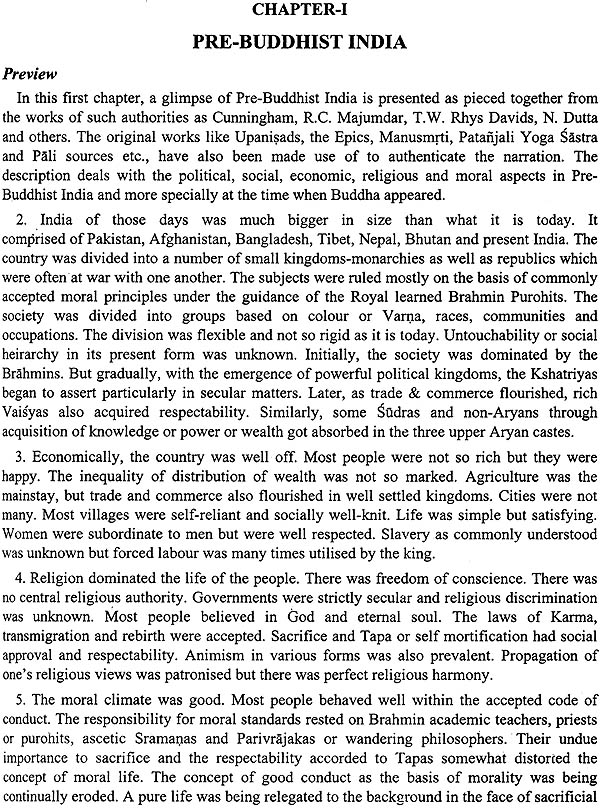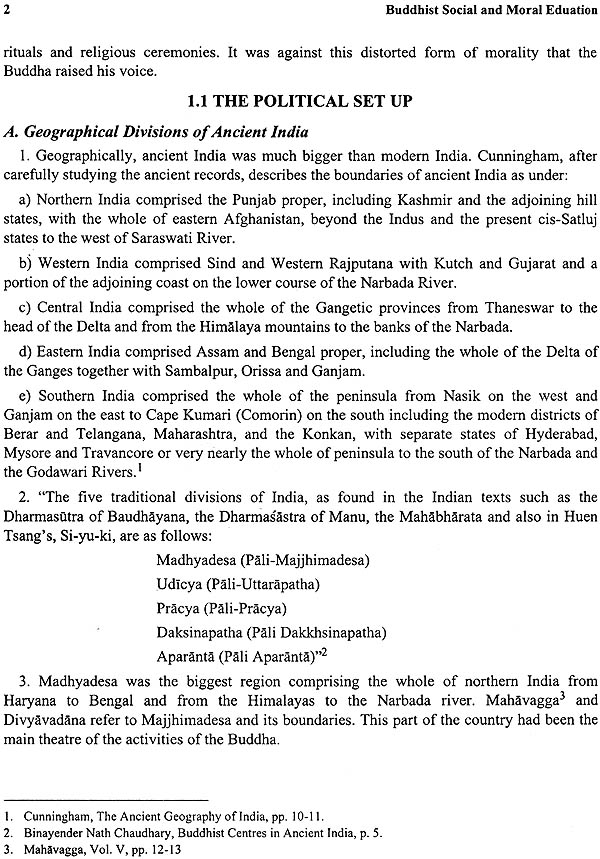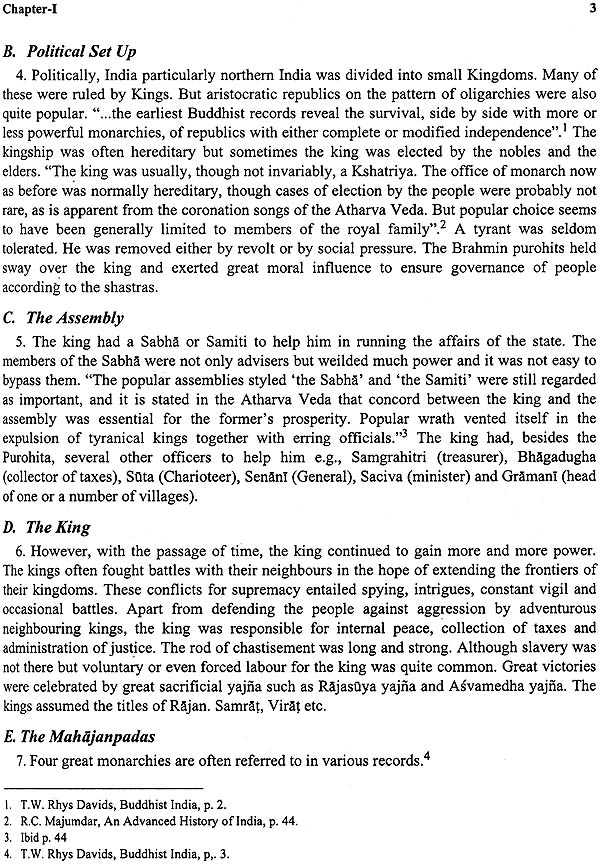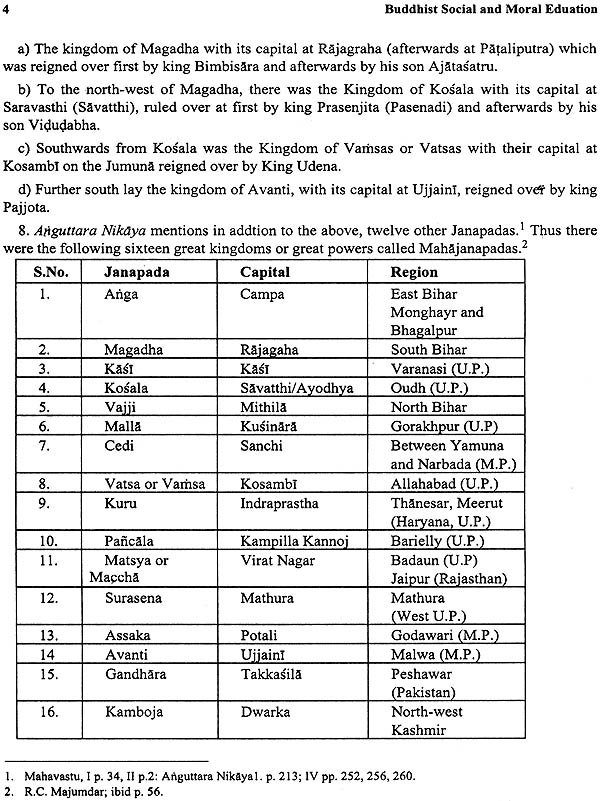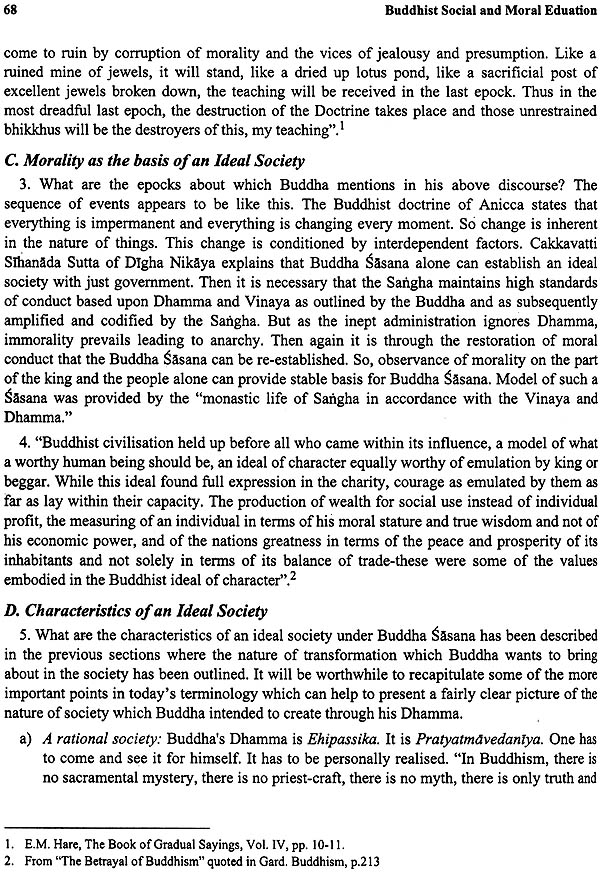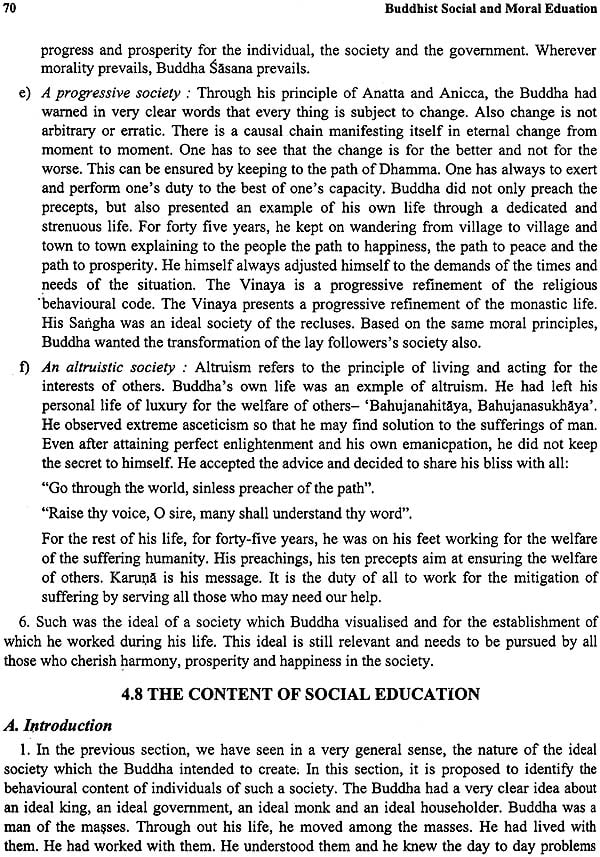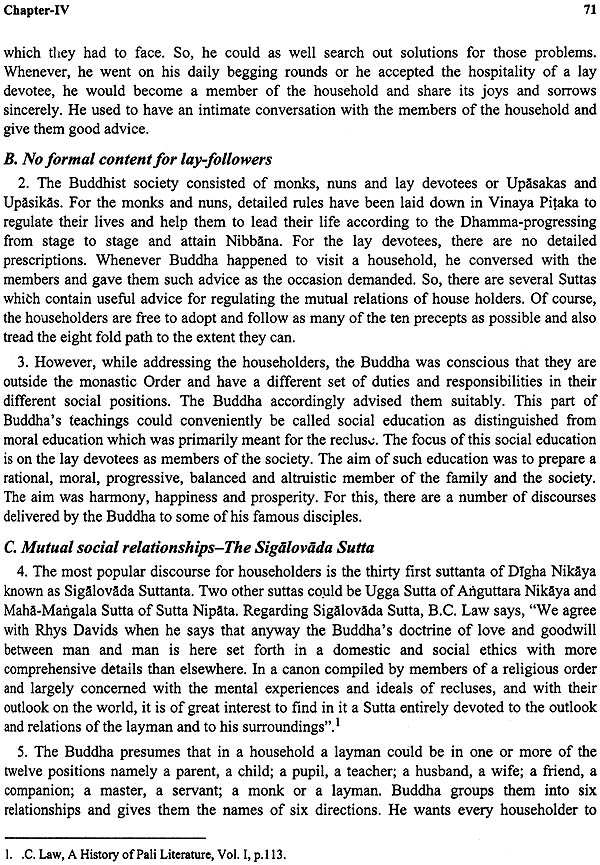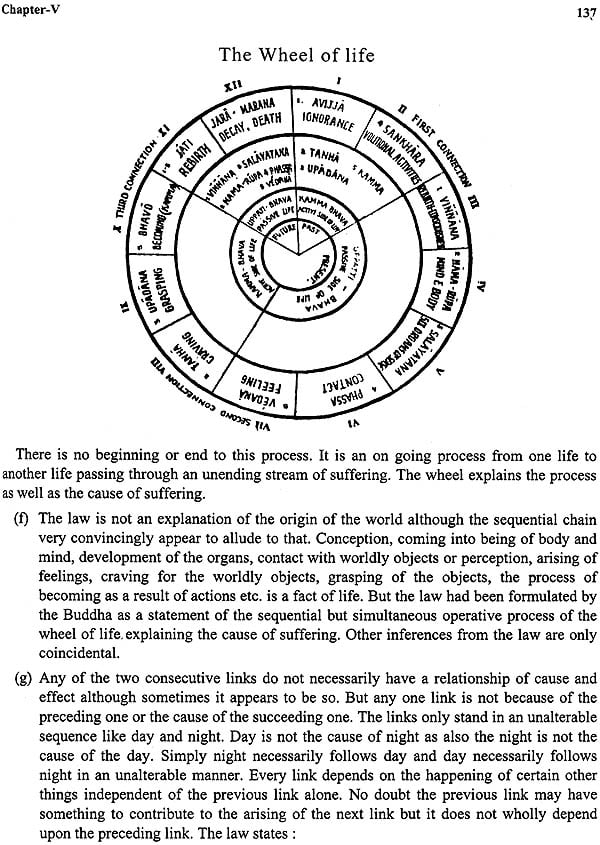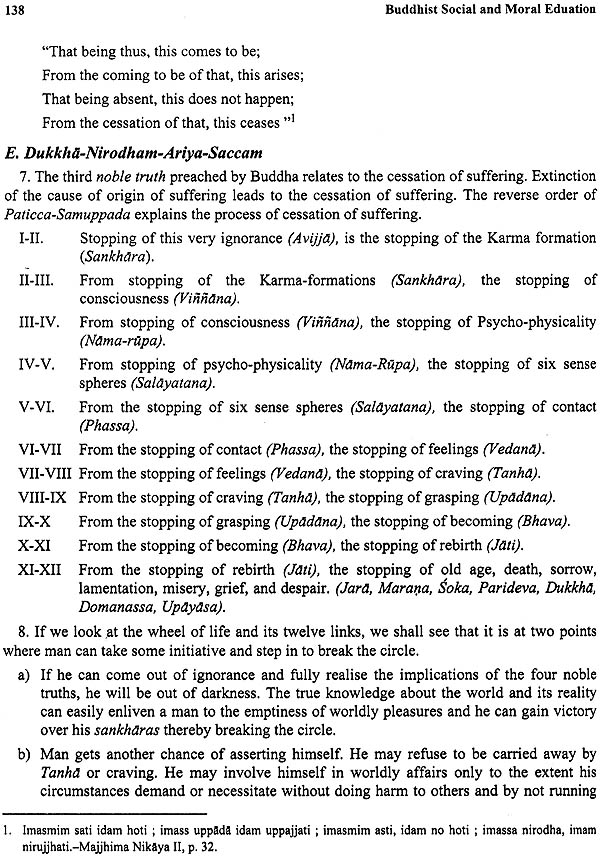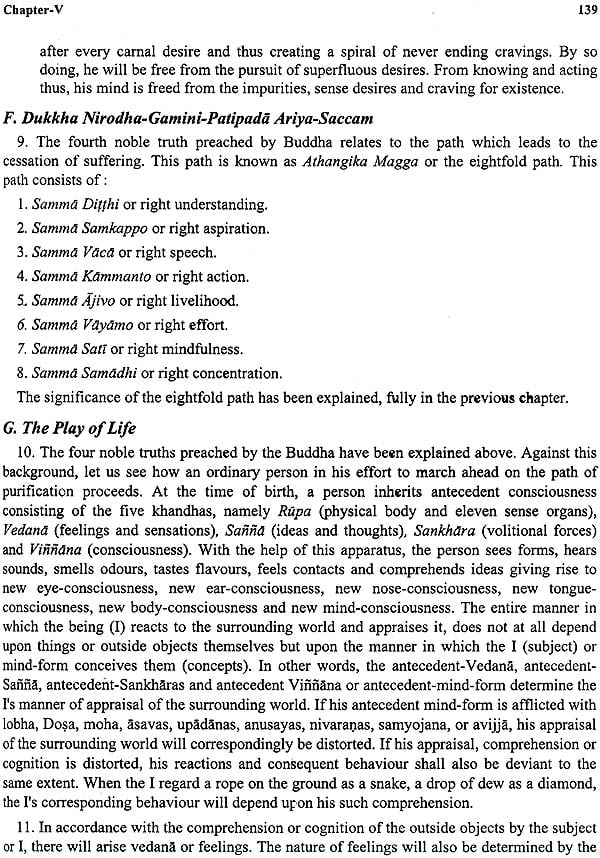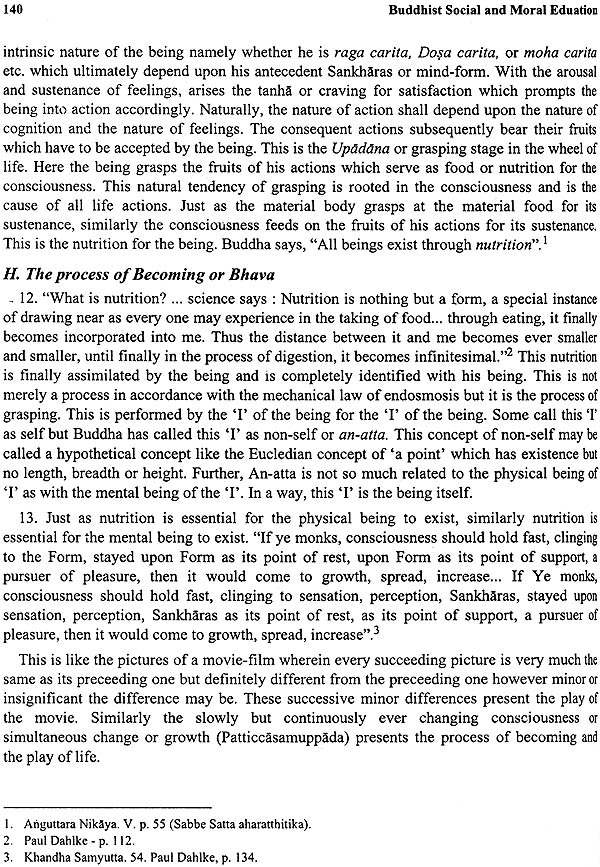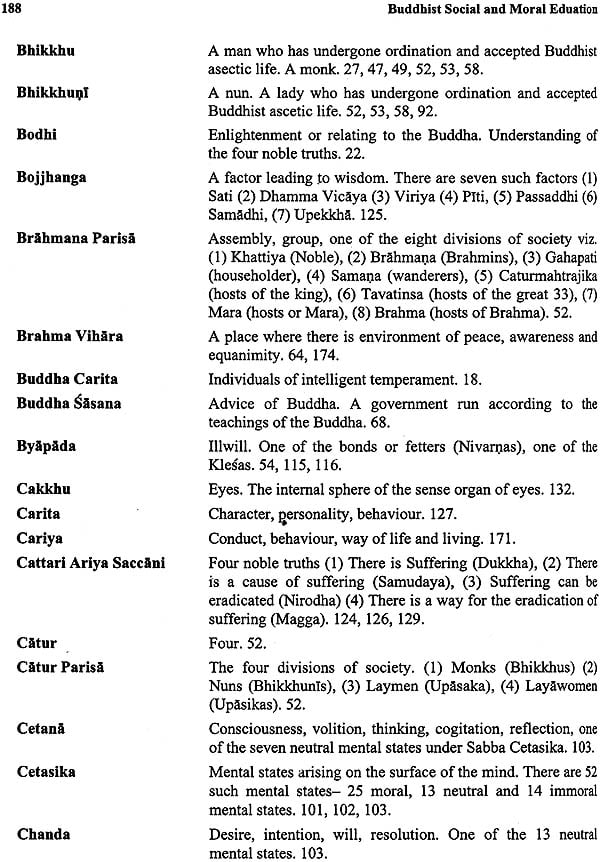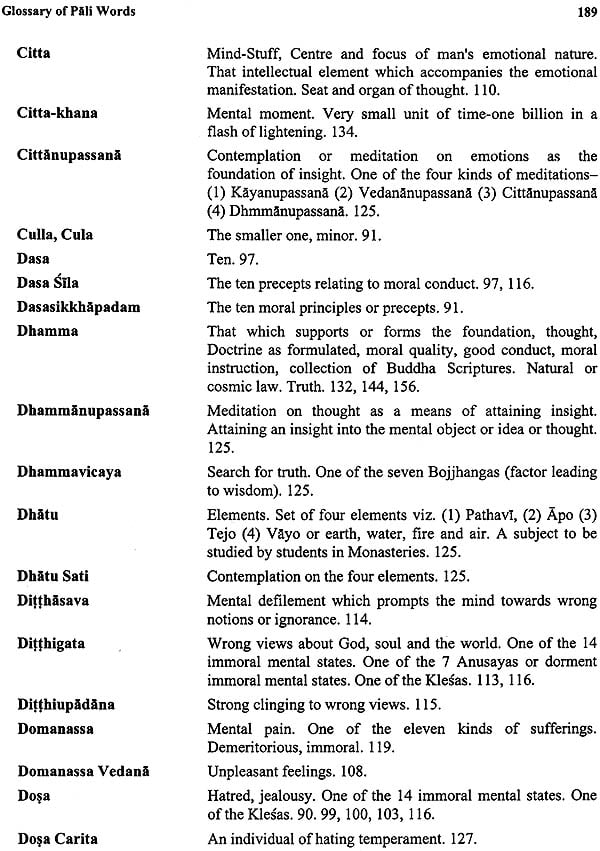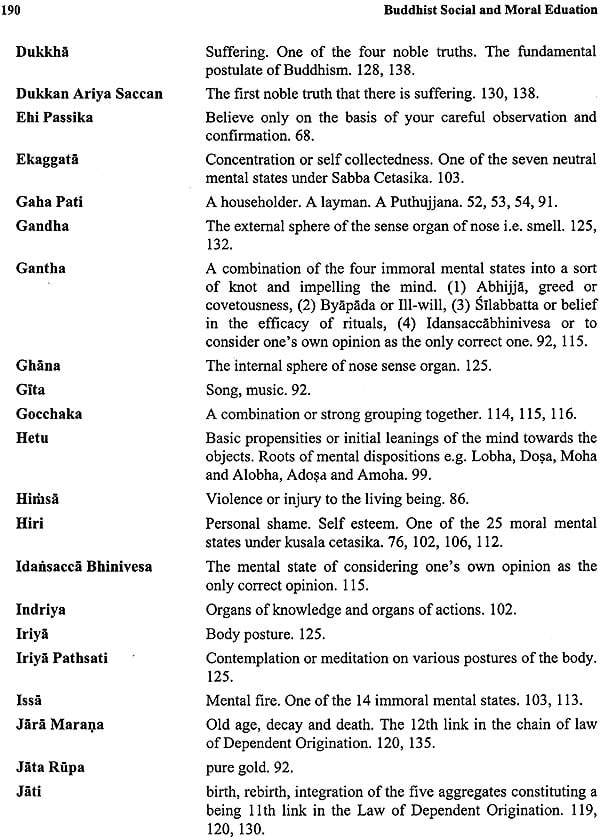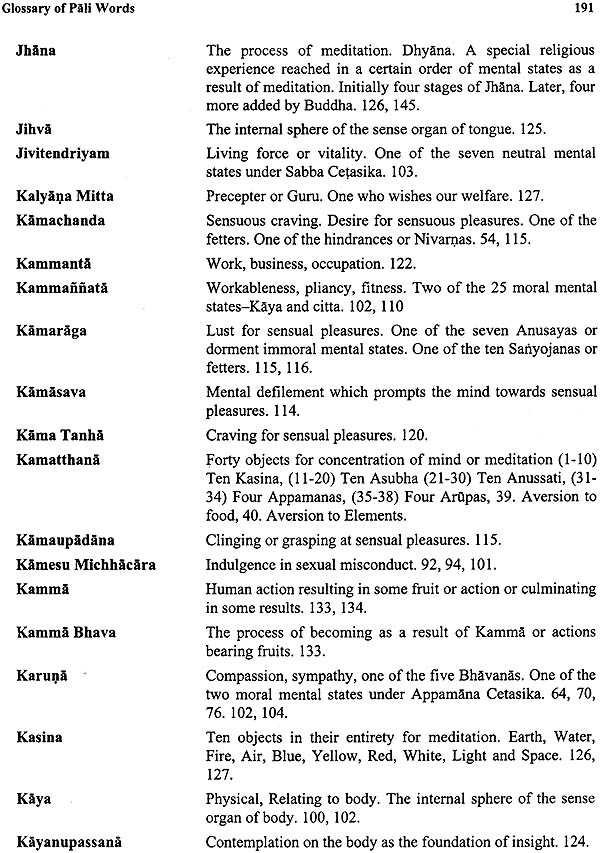
Buddhist Social and Moral Education
Book Specification
| Item Code: | NAF355 |
| Author: | Dr. Suraj Narain Sharma |
| Publisher: | Parimal Publication Pvt. Ltd. |
| Language: | English |
| Edition: | 2011 |
| ISBN: | 9788171103744 |
| Pages: | 250 |
| Cover: | Hardcover |
| Other Details | 9.5 inch x 7.5 inch |
| Weight | 650 gm |
Book Description
Everybody is conscious of the erosion of moral values, widespread corruption, dereliction of duty, social conflicts, religious intolerance and rampant in-discipline. But there are genuine difficulties ideological, psychological and practical which need to be studied, sorted out and clarified before any effective measures can be taken to solve the problems. Various offorts have been made in the past by different education commissions and committees to prepare a blue print for moral and social education of the young generation for their moral regeneration and social transformation. But for various reasons, the educational system of the country could not respond to the different proposals. Perhaps there is no escape except to find a way out. Buddha’s moral code which is national and psychological, scientific and humanistic can admirably serve as a good starting point.
A humble effort has been made in this book to present a bird’s eye-view of the Buddhist morality so as to set the ball rolling in this direction.
Born in 1923, Dr. S.N. Sharma has been a student for the last 70 years acquiring knowledge in various disciplines of education. He is active in the field of education. He is active in the field of education for the last 57 years in various capacities. Starting from a Secondary School teacher, Dr. Sharma retired as Deputy Director of Education in Delhi Administration. Dr. Sharma, a man of clear vision, has very laboriously dug out from the ocean of Buddhist literature, the salient points of ‘Buddhist Social and Moral Education’, which the present materialistic world needs most to reconstruct its social and educational base for a better world.
Sixth century B.C. was the age of social awakening and religious fermentation. A number of teachers appeared in the field and preached various types of doctrines. Purana-Kassapa preached the theory of “No action”. According to this theory, there was neither any good result of moral actions nor any bad result of immoral ones. Makkhali Gosala gave the sermon of purification of beings through constant transmigration. Ajitakesa-Kamhala was materialist. According to him, all the wise and the fool were to meet the same destiny of annihilation. Similarly Pakudhakaccayana explained the doctrine of seven independent bodies functioning without reference to anyone. There is the doctrine of fourfold restraints preached by Nigant hanataputta-Sanjayabelatthaputta was totally agnostic. The theories preached by these teachers were of conflicting nature and had no fundamental base. They were the imaginative flights and not concerned with practical life. The people in general were confused and bewildered while pondering over them.
On such an occasion, appeared the Buddha, the most practical and popular teacher. He understood the basic problem of the people and exerted for forty five years to find out a harmonious solution. He realized that there was need of social awakening and moral upliftment. And therefore he laid more emphasis on moral teachings (Sila). This formed the first step of his path. The Panca-Sila, Attha-Sila, Dass-Sila, Patimokkha-sambara-sila, Indriya-sambara-sila, Ajiva-Parisudhi-sila, Paccaya-Sanmsita-sila etc. were its various expressions. The discourses relating to social uplifment were the Sigalovada-Sutta, Vasala-Sutta, Mangala-Sutta, Parahava-Sutta, Alavaka-Sutta, Duhita-Sutta etc. Besides, there are a number of discourses, scattered here and there in the Tipitaka which explain the social and moral norms.
All these discourses are available in Pali canon. They have been commented upon in the Atthakathas, Tikas Anutikas and independent texts in Pali. There is fragmentary literature in English, Hindi and other modern Indian languages. Dr. S.N. Sharma, and erudite scholar of education, has marked this academic hiatus and going deep into the original materials as well as the researches done on the topic, has presented an authentic account of the Buddha’s Social and Moral Education in a Lucid style in English. It has become possible by a person like Dr. Sharma who has actively engaged himself in the solution of the problems related to it. The book is authentic in prescribing the Buddha’s views on the subject and he has discussed almost all the major issues in a very systematic way. The book in its present form is equally useful for people interested in education, Buddhism and social sciences.
I wish him a prosperous life, devoted to pondering over educational problems and bringing out some practical solutions for social and moral education in the present day social order.
A. Meaning of morality
1. Morality, according to Oxford Dictionary is concerned with character. It is concerned with the disposition or with the distinction between right and wrong. Chamber’s Dictionary points out that morality is related to character or conduct considered as good or evil; ethical; conformed to or directed towards right; virtuous. Thus morality seems to imply socially approved conduct, virtue or good character. It also refers to “Standard of human behavior determined either subjectively or objectively and based on what is considered ethically right or wrong”.
2. Sometimes, the word ethics is used synonymously with morality. The word morality has been derived from the Latin word ‘Mores’ which means the custom or habit or the way of life. The word ‘ethics’ has been derived from the Greek words ‘ethike’ and ‘ethos’ meaning custom, habitual conduct, usage and character.
3. There are various terms related to morality. A look at dictionary meanings of these word will help to clarify the implications of the word morality. ‘Moral sense’ refers to the power of distinguishing between right and wrong or sense dealing with regulation of human conduct. ‘Moral courage’ means the courage to encounter contempt rather than abandon the right course. ‘Moral Law’ refers to those requirements to which right conduct must conform. ‘Morally Good’ implies virtuous as regards general conduct. ‘Moral Philosophy’ is the same think as ethics. ‘Ethics or moral philosophy is that branch of philosophy that is concerned with what Is morally good and bad, right and wrong. Its central concern is the double task.
(i) Of meta-ethics, of analyzing the meaning and nature of the normative moral elements in man’s actions, though and language and of the methods of supporting moral judgments, and
(ii) Of normative ethics such as evaluating these elements and methods by developing criteria for justifying rules and judgment of good and right and presenting, analyzing and appraising them”.
B. The Moral code
4. From the above definitions of morality and ethics and their derivatives, the following points emerge:-
(a) Morality and ethics are concepts related to human conduct and character.
(b) They refer to a set of ‘virtues’ more or less of universal nature and valued as such by most persons and carrying the implication of ‘good’ as opposed to ‘bad’. It is with reference to these virtues that the conduct of human beings is evaluated and judged. This gives birth to a moral code of conduct.
(c) They refer to a mode of behavior approved by the society as ‘right’ and ‘desirable’ as against their opposite and disapproved by the society as ‘wrong’ and ‘undesirable’. This gives birth to a manual of social ethics. The moral code and social ethics are based on a philosophical frame normally borrowed from some religion which justifies the elements incorporated in the moral code and social ethics.
(d) The moral code as well as social ethics are enforced through social pressure and personal persuasion and not by the law of the land.
5. The logical concomitants of of moral code and social ethics are as under :-
(a) The moral code of conduct and social ethics point to a way of moral and ethical life which human beings are expected to emulate and adopt in their own life.
(b) Subsequently, a path with a set programme is also outlined by following which the ideals of a moral and ethical life are intended to be achieved.
(c) This programee is proposed to be implemented through the agency of various social institutions and their functionaries. Apart from home, two of the most important of these institutions have been the church and the school the main functionaries of these institutions are called the mother, the priest and the teacher.
(d) The family, the society, and other social institutions are supposed to support the whole system of moral code and social ethics and persuade as well as presurise the individual to know, understand, accept, adopt and imbibe in himself the prescribed moral code and the social ethics.
(e) The social harmony, the economic prosperity and the individual happiness depent upon the nature of the moral code, the sincerity of implementing agencies and the support which other social institutions provide to the implementing agencies.
C. The Vedic system of Morality
6. Every society throughout its history has been trying to achieve these personal and social ideals. The vedic Rishis, the Jain ascetics, the Buddhist monks and the modem social philosophers have all presented a moral code and a social ethics based on a philosophical frame. Each was a product of the social and religious thought of his age. The Vedic Rishis had presented the ideal of a moral man against the metaphysical background of Supreme Brahma and the immortal soul. Yoga (concentration and control of mind) was the technique; Nishkam Karm a (engaging in actions with a detached mind ) was its social frame; yajna (sacrifice)was its ceremonial ritual; an austere, virtuous and ascetic life was its ideal and reunion of the struggling soul with the supreme Brahma in a state of permanent bliss was its ultimate aim. The whole scheme was implemented through the Asrama or Gurukul system of education with the authority of the Vedas, active support of the religious purohits and the political monarchs. This was also done through the social institutions like the panchayats or gram sabhas and caste councils.
D. The Jain system of morality
7. As against this, “Jainism advocates an attitude of equality and designates the whole pattern of religious conduct and philosophical thought that helps to develop such an attitude….. this attitude finds expression in the principle of non-violence or non-injury (ahimsa). To separate courses of conduct are laid down for the ascetics and householder (laymen). In both cases, the code of morals is based on the doctrine of ahimsa. Since thought is considered the father on action, violence in thought (Bhava Himsa) merely precedes physical injury (Dravya Himsa)… Jainism enjoins avoidance of all forms of injury (himsa)- physical or otherwise, whether committed by mind, body or speech… right faith (Samyag Darsana), right knowledge (samyag Jnana) and conduct (Samyag caritra )are the three jewels.”
E. The Buddhist system of morality
8. “The religion of the Buddha stressed the universal norms that are constant, apply to everyone and do not conflict with human nature. The way of Goutam Buddha is called the middle path because it avoids both the extremes of outright pursuit of worldly desires and the practice of severe discipline of self mortification followed by ascetics”.
F. Social Education
9. The focus of moral education is the individual and his upliftment. Social education concentrates on ensuring the stability and progress of the society as a whole. Although, the society is an aggregate of the individuals and id moral upliftment of all individuals can be ensured, society will naturally progress. However, this presumption is more of a pious wish than an actual reality. Social education has to be arranged specifically. Also, there are various social organizations-formal as well as informal which have an individuality of their own and these organizations do perform specific functions to ensure the security, stability, prosperity and happiness of the society as a whole. Family, state, government, church etc. are such social organizations.
10. It is also to be noted that moral education can conveniently be combined or integrated with the general education and imparted through formal educational institutions from a very early period. This was so even in ancient India under the Vedic as well as the Buddhist systems of education. As opposed to this, social education or a major part of it has to start later in life say when the individual enters family or adult social life. It is at that time that there is readiness on the part of the individual to receive such social education. Then again such education has to be through informal methods and through agencies other than those responsible for formal general education. It is the responsibility of the family, the church, the government and such other social organization. Also, many social reformers, academicians, religious leaders and others to voluntarily assume such responsibility of educating the masses in their social obligations.
11. The system of social education in ancient India was almost the same under the Vedic, Jain and Buddhist systems. The academic teachers, purohits, ascetics and paribrajakas during their begging rounds, rainy season resorts, invitation visits to householders and on such other occasions conversed with members of the family, answered their querries, removed their doubts and tem good advice. The monks, nuns and Jain ascetics also performed the same functions. The content of this social education was almost the same under the three systems with slight variations.
G. The subject of this book
12. The main theme of this book is to describe the system of moral and social education which was advocated by the Buddha and as it found expression in the Tipitaka. The presentation consist of five chapters; Chapter I describes the political, social, economic, religious and moral conditions as they prevailed in pre-Buddhist India. The description naturally leads to the unfolding of circumstances which gave birth to a social and religious reformatory movement. This movement was spearheaded by Gautam Buddha. Chapter II describes the appearance of the Buddha, his renunciation, enlightenment, preaching of the Dhamma and spread of the new religion through the then known Madhya Desa. The chapter includes a description of the main constituents of the canonical Pali literature popularly known as Tipitaka as also the main tenets of the religion of the Buddha.
13. In chapter III, we have a look at the education system which had been adopted, modified and developed by the Buddhist monasteries for the propagation of morality and social ethics according to Buddhist tradition and as depicted in the Pali Tipitaka. It is made clear how the religion of Buddha transformed the existing educational system to suit its aims of moral regeneration and social transformation. Chapter IV, describes in detail the social set up according to the Buddhist tradition as also the content and technique of social education adopted by the Buddha and his disciples.
14. in chapter V, we describe in detail the nature of morality which Buddha preached. Also, it is made clear what techniques of moral development have been advocated in the Tipitaka. The relevance of Buddha’s moral precepts and social ethics to present day conditions has also been brought out in a section of chapter V. later, some recent experiments in moral education undertaken in the west are juxtaposed to bring out the difference in the approach of the west and the east on this important human endeavour. Towards the end, an attempt will be made depicted in the Tipitaka and the ways and means to fit them into the present day educational system.
| Foreword | V | |
| Introduction | VII | |
| Chapter-I | Pre-Buddhist India | 1-16 |
| 1.1 | The political set up | |
| 1.2 | The Social Order | |
| 1.3 | The Economic Order | |
| 1.4 | The Moral Order | |
| Chapter-II | The Buddha | 17-34 |
| 2.1 | Appearance of the Buddha | |
| 2.2 | The Great Renunciation | |
| 2.3 | The Perfect Enlightenment | |
| 2.4 | Setting the Wheel of Righteosness into motion | |
| 2.5 | Preaching the Dhamma | |
| 2.6 | Entering into Mhaparinibbana | |
| 2.7 | Description of Tipitakas | |
| Chapter-III | The system of Education | 35-46 |
| 3.1 | The pre-Buddhist System of General Education | |
| 3.2 | The Buddhist System of General education | |
| 3.3 | The Buddhist Educational Intitutions | |
| Chapter-IV | Social Education under Buddhism | 47-80 |
| 4.1 | Social order according to Buddhist tradition | |
| 4.2 | The Divisions of Society | |
| 4.3 | Laymen and Laywomen | |
| 4.4 | Monks and Nuns | |
| 4.5 | Basic Principles of Solidarity and Upliftment of the society | |
| 4.6 | The state and Social Welfare | |
| 4.7 | The Social ideals and the Social Education needs | |
| 4.8 | The Contents of social Education | |
| 4.9 | Techniques of Social education | |
| Chapter -V | Moral Education as Depicted in Pali Tipitaka | 81-176 |
| 5.1 | The Vedic system of Moral Education | |
| 5.2 | Buddhist Morality | |
| 5.3 | The first level of Buddhist Morality | |
| 5.4 | The second level of Buddhist morality | |
| 5.5 | The third Level Of Buddhist morality | |
| 5.6 | The Ultimate Aim of buddhist Morality | |
| 5.7 | The Content of Moral Education | |
| 5.8 | The methods of Moral Education | |
| 5.9 | Buddhist Technique of Vipassana meditation | |
| 5.10 | Buddhist Morality and modern man | |
| Conclusion | ||
| Bibliography | 177-184 | |
| Glossary of Pali Words | 185-201 | |
| Glossary of Pali Proper names | 203-218 | |
| Glossary of Sanskrit Words | 219-224 | |
| General Index | 225-230 |
